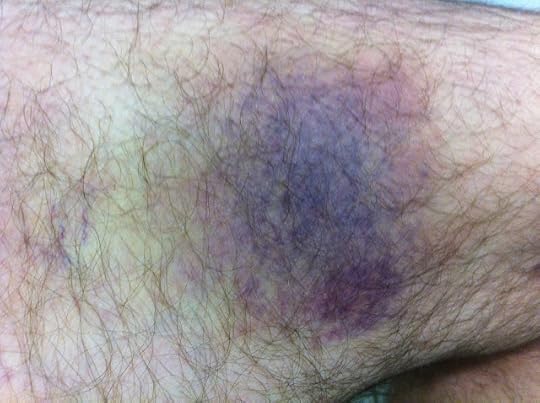At the Sight of the Bruise
 Bruise on My Left Thigh (29 November 2011)
Bruise on My Left Thigh (29 November 2011)It all started when I fell up the stairs.
It is so more likely for someone to fall down the stairs that I always have to emphasize the word "up" when I tell this story.
I am now weeks into a project to pack up 2000 of my wordbooks (dictionaries, antidictionaries, thesauri, grammars, usage guides, and even monographs on all aspects of language). These I will be donating to the University at Albany in the next couple of weeks, and I never imagined the dangers to my health that such a project entailed.
One day a few weeks ago (the 20th of November), I was carrying two heavy boxes upstairs. (These were actually boxes of my papers, which is the other part of this project.) Just before I made it to the landing, I slipped on the stairs, the weight of the boxes helped pull me down faster, and I landed hard on the corner of the second from the top step with the outside of my left thigh. One of the boxes spilled its contents onto the landing, so I cleaned that up and then I lay down for a while, keeping ice over the point of impact. I went to bed early that night.
The next morning, my leg was still sore, but not much. I had no bruise on my leg at all, and as the days passed my pain slowly subsided. Then on the morning of the eighth day after my accident, I sat down on the toilet and noticed a brand new bruise on my leg, but on the inside of my thigh. It was large, deep purple in the center, flaring out into red, and dissipating finally into that sick shade of green associated almost entirely with bruises.
I thought it amazing that it took over a week for the bruise to show, especially since I had imagined I wouldn't be bruising. After all, I don't bruise easily.
What I didn't realize was that, along with the bruise, I would begin to experience greater pain. Suddenly I had pain that centered on my thigh and calf but that went all the way down to my ankle. The pain was frequent but not constant. It would change places suddenly and without notice. I began to limp.
Eventually, my leg began to seize up, especially if I didn't use it. When I stood after sitting for long periods of time cataloging books to donate away, my leg would cramp up, making the first step with my left leg painful. Worst of all, my leg would cramp up when I slept, and I would away to painful burning cramps six or so times a night.
This past Monday, I decided to visit the doctor, electing to take an appointment late in the day. Yet it wasn't late enough. After waiting thirty minutes past the time of my appointment, I went up to the woman at the counter and asked if I'd been lost in the shuffle. The response was that I was next, and that they hoped they would be able to get to me soon.
And soon enough they did. The nurse weighing me told me she liked my tie, a subtle pattern of ladybugs that people rarely recognize as such.
I didn't see my doctor but a physician's assistant named Kathleen, and she couldn't figure out the problem. She was very thoughtful, asked questions, and allowed me to ask questions, but she didn't know why the bruise took so long to show and why it showed on the opposite of the leg, and further down as well. She told me to take three ibuprofen twice a day, and to call if the situation worsened. She was adamant about this directive, because she'd quickly learned that I'm only vaguely interested in my health. I think she realized this during this conversation:
Kathleen: What medicine's do you take?
Geof: I've no idea. There are too many of them?
Kathleen: You don't know the names of your medicines?
Geof: No. You know how some people are really interested in their health? I'm not one of those people.
Kathleen: Well, you really should know what medicines you're taking. You should keep a list with you.
Geof: I'm never going to do that.
Kathleen (looking in my thick patient folder): I see you take [and she names a bunch of medicines I don't remember the names of now].
Geof: I remembered that two of them had almost the same name. And see? I don't need to remember them. You can look them up.
Kathleen: You need to know your medicines. What if you go to an emergency room, and don't know your medicines?
Geof: I'll never go to an emergency room again.
Kathleen: Why not?
Geof: Because it's always a waste of time.
Somehow, I did not annoy her with my natural obstinacy. I did ask questions, though they were focused on figuring out why the bruise took so long to show. She said I was the most analytical patient she'd ever had. I said I was paid to think.
She also sent me deeper into the hospital for an ultrasound of my leg. I asked, "Is this so we can make sure the baby's okay?" She didn't answer, but maybe she laughed. She was sending me for an ultrasound so that we could discover if I had deep-vein thrombosis (which is a serious condition that can lead to death) or phlebitis (swelling of the veins).
After waiting in two more waiting rooms, a sonographer named Amy conducted the test of my leg. It was a bit boring sitting there without a screen to show me the veins she was following. And she told me that, if I had deep-vein thrombosis, they wouldn't let me leave the hospital. They let me go, but without telling me what the results were.
The next day, I discovered I had superficial vein thrombosis, which is associated with no dangers.
Later that day, however, I called the doctor again and set up an appointment, because the bruise started spreading, popping up in a non-contiguous part of my leg. This seemed like worsening, so the call seemed necessary, though I wasn't at all sure.
This time, my own doctor ("Joey," I called him) showed up, entering the room while saying, "Let's take off the leg!"
"That's what I thought!" I said.
(The man knows me a little, so he can tell jokes.)
He decided that what happened was that the fall damaged the entire muscle group in my thigh, and that this caused bleeding internally that was slowly spreading through the leg (downward apparently because of the force of gravity). He assumed that the bruised had been spreading because the ibuprofen was a blood thinner, so he took me off that regimen and told me not to take my daily aspirin for a week either.
And Kathleen gave me a prescription for a heavy painkiller. I still awoke to cramps the first night I took them, but the dosage in the morning kept me groggy all through the work day, though my pain didn't decrease. I reduced the diurnal dosage the next day.
My pain has slowly subsided over the next few days, though I'm not sure if it was the painkiller alone that made that happen, or if my leg is improving. The bruise is dissipating, so maybe the leg is getting back to normal. Still, I limped for a little bit today.
I received the painkiller in a container with warnings stuck all over it, and until a few minutes ago I thought there were only three warnings. But I have just discovered that one of the warnings was pasted over a fourth:
DO NOT DRINK ALCOHOLIC BEVERAGES WHEN TAKING THIS MEDICATION.
Hmm, would've been good to've known about that a few days ago.
ecr. l'inf.
Published on December 10, 2011 19:26
No comments have been added yet.



